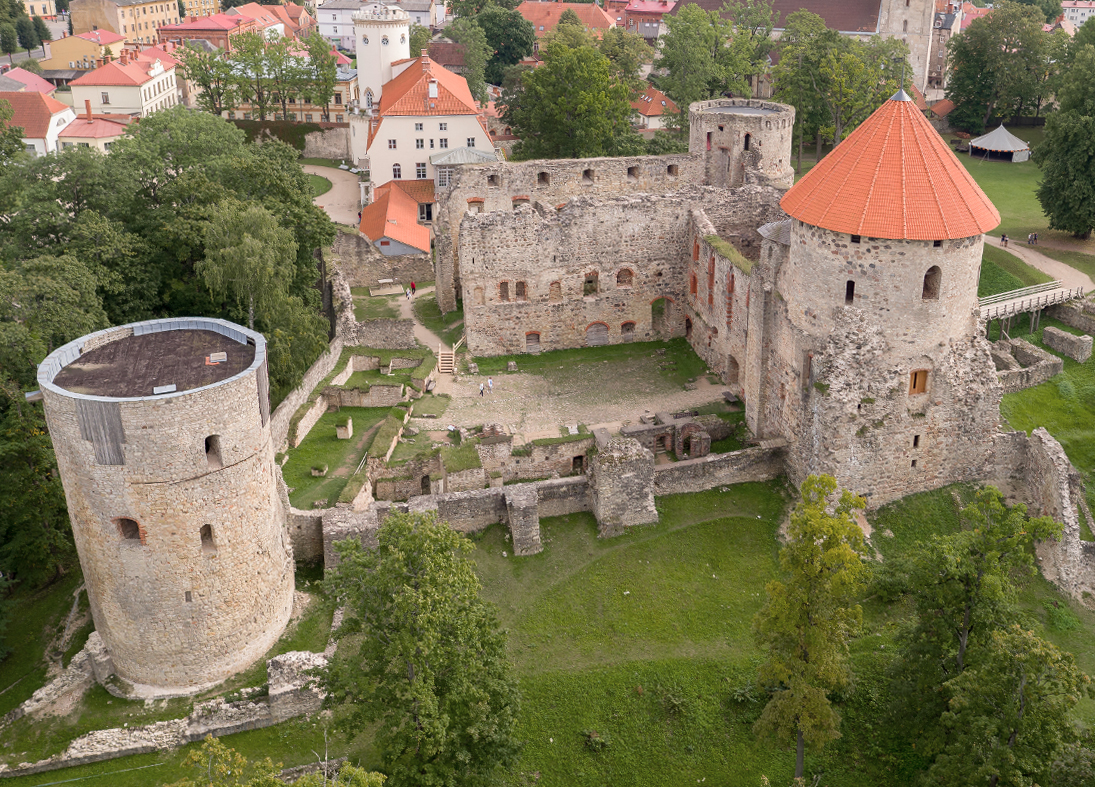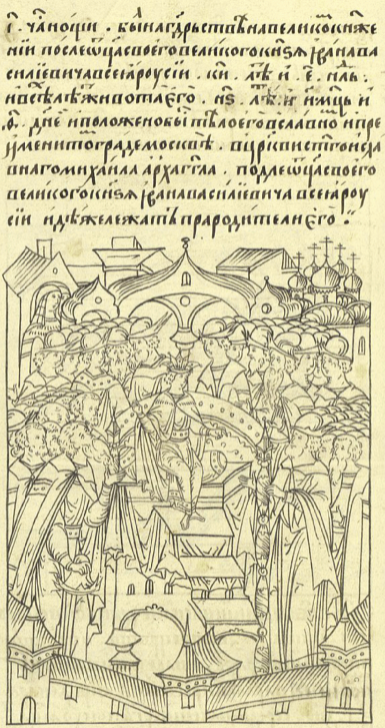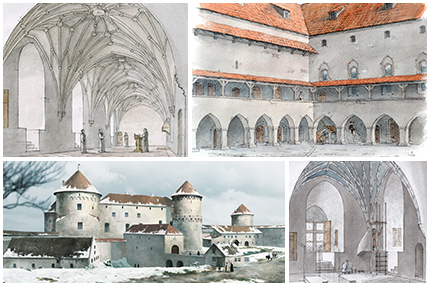|
Siege Of Cēsis Castle (1577)
The siege of Cēsis Castle (1577) was a part of Ivan the Terrible, Ivan the Terrible's campaign to conquer Terra Mariana, Old Livonia. After a five-day-long bombardment, about 300 people within the castle committed mass suicide by blowing themselves up with four barrels of gunpowder. The event is regarded as one of the greatest tragedies in the war-torn Europe of the early modern period. Background After the dissolution of the Livonian branch of the Teutonic Order in 1561, Cēsis Castle, one of the region's most important fortresses, was garrisoned by Polish troops. In the summer of 1577, the townsmen of Cēsis drove the Polish garrison from the castle and submitted to Magnus, Duke of Holstein, Magnus, the titular King of Livonia. Soon after Magnus have moved to Cēsis the Muscovites, personally led by Ivan the Terrible, arrived at the edge of the town. The tsar had a reputation for not sparing even those who willingly surrendered, and therefore the decision was made not to open ... [...More Info...] [...Related Items...] OR: [Wikipedia] [Google] [Baidu] |
Ivan The Terrible
Ivan IV Vasilyevich (; – ), commonly known as Ivan the Terrible,; ; monastic name: Jonah. was Grand Prince of Moscow, Grand Prince of Moscow and all Russia from 1533 to 1547, and the first Tsar of all Russia, Tsar and Grand Prince of all Russia from 1547 until his death in 1584. Ivan's reign was characterised by Russia's transformation from a medieval state to a fledgling empire, but at an immense cost to its people and long-term economy. Ivan IV was the eldest son of Vasili III of Russia, Vasili III by his second wife Elena Glinskaya, and a grandson of Ivan III of Russia, Ivan III. He succeeded his father after his death, when he was three years old. A group of reformers united around the young Ivan, crowning him as tsar in 1547 at the age of 16. In the early years of his reign, Ivan ruled with the group of reformers known as the Chosen Council and established the ''Zemsky Sobor'', a new assembly convened by the tsar. He also revised the Sudebnik of 1550, legal code and in ... [...More Info...] [...Related Items...] OR: [Wikipedia] [Google] [Baidu] |
Terra Mariana
Terra Mariana (Medieval Latin for 'Land of Mary (mother of Jesus), Mary') was the formal name for Medieval Livonia or Old Livonia. It was formed in the aftermath of the Livonian Crusade, and its territories were composed of present-day Estonia and Latvia. It was established on 2 February 1207, as a principality of the Holy Roman Empire, and lost this status in 1215 when Pope Innocent III proclaimed it as directly subject to the Holy See. The papal legate William of Modena divided Terra Mariana into feudal principalities: the Duchy of Estonia (1219–1346), Duchy of Estonia (dominum directum to the king of Denmark); the Archbishopric of Riga; the Bishopric of Courland; the Bishopric of Dorpat; the Bishopric of Ösel–Wiek; and territories under the military administration of the Livonian Brothers of the Sword. After the 1236 Battle of Saule, the surviving members of the Brothers merged in 1237 with the Teutonic Order of Prussia and became known as the Livonian Order. In 1346 the ... [...More Info...] [...Related Items...] OR: [Wikipedia] [Google] [Baidu] |
Teutonic Order
The Teutonic Order is a religious order (Catholic), Catholic religious institution founded as a military order (religious society), military society in Acre, Israel, Acre, Kingdom of Jerusalem. The Order of Brothers of the German House of Saint Mary in Jerusalem was formed to aid Christians on their pilgrimages to the Holy Land and to establish hospitals. Its members have commonly been known as the Teutonic Knights, having historically served as a crusades, crusading military order for supporting Catholic rule in the Holy Land and the Northern Crusades during the Middle Ages, as well as supplying military protection for Catholics in Eastern Europe. Purely religious since 1810, the Teutonic Order still confers limited honorary knighthoods. The Bailiwick of Utrecht of the Teutonic Order, a Protestant order of chivalry, chivalric order, is descended from the same medieval military order and also continues to award knighthoods and perform charitable work. Name The name of the Or ... [...More Info...] [...Related Items...] OR: [Wikipedia] [Google] [Baidu] |
Cēsis Castle
Cēsis Castle () is one of the most iconic and best preserved medieval castles in Latvia. The foundations of the castle were laid 800 years ago by the Livonian Brothers of the Sword. The most prosperous period Cēsis Castle experienced was during its next owners, the Teutonic Order. It became one of the key administrative and economic centers of the Teutonic Order in Livonia and was a seat of Landmeister in Livland. The first serious damage was done to the castle during the Livonian War, when it was besieged by the army of Ivan the Terrible. In the course of the siege of 1577 approximately 300 people within the castle committed mass suicide by blowing themselves up with gunpowder. Cēsis Castle was still in use during the following century but it fell into disuse after the Great Northern War. Today the castle is the most visited heritage site in Cēsis and one of the 'must see' destinations in the Baltic states. History Foundation and expansion In the autumn of 1206 during th ... [...More Info...] [...Related Items...] OR: [Wikipedia] [Google] [Baidu] |
Magnus, Duke Of Holstein
Magnus of Denmark or Magnus of Holstein ( – ) was a Prince of Denmark, Duke of Holstein, and a member of the House of Oldenburg. As a vassal of Tsar Ivan IV of Russia, he was the titular King of Livonia from 1570 to 1578. Early life Duke Magnus was born at the Copenhagen Castle in 1540 as the second son of King Christian III of Denmark and Norway and Dorothea of Saxe-Lauenburg. At the age of 17 he was sent to Germany to be educated at various German courts. Following the death of his father in 1559, he returned to Denmark for the coronation of his older brother, King Frederick II of Denmark. The same year, the prince-bishop of Ösel-Wiek and Courland Johannes V von Münchhausen in Old Livonia sold his lands to King Frederick II for 30,000 thalers. To avoid hereditary partition of his lands, King Frederick II gave that territory to his younger brother Magnus on condition that he renounced his rights to succession in the duchies of Schleswig and Holstein. In 1560, Magnus ... [...More Info...] [...Related Items...] OR: [Wikipedia] [Google] [Baidu] |
Cesis Castle 2017-09-10
Comitato Esecutivo per i Servizi di Informazione e Sicurezza () was an Italian government committee whose mission was the coordination of all the intelligence sector, and specifically between the two civilian and military intelligence agencies (respectively, SISDE and SISMI), with the aim to report all the relevant information collected by it to the political Authorities, represented by the Presidency of the Council of Ministers. With the reform of the Italian Intelligence Services approved on 1 August 2007, CESIS was replaced by DIS.Legislative Act n.124 of 08/03/2007, reported on the Official Gazette of the Italian RepublicGeneral Series, n.187 of 08/13/2007 History Since the end of World War II, Italian intelligence agencies have been reorganized many times in an attempt to increase their effectiveness and bring them more fully under civilian control. The committee was established as part of a broader reform of the Italian intelligence community, which represented the late ... [...More Info...] [...Related Items...] OR: [Wikipedia] [Google] [Baidu] |
Conflicts In 1577
Conflict may refer to: Social sciences * Conflict (process), the general pattern of groups dealing with disparate ideas * Conflict continuum from cooperation (low intensity), to contest, to higher intensity (violence and war) * Conflict of interest, involvement in multiple interests which could possibly corrupt the motivation or decision-making * Cultural conflict, a type of conflict that occurs when different cultural values and beliefs clash * Ethnic conflict, a conflict between two or more contending ethnic groups * Group conflict, conflict between groups * Intragroup conflict, conflict within groups * Organizational conflict, discord caused by opposition of needs, values, and interests between people working together * Role conflict, incompatible demands placed upon a person such that compliance with both would be difficult * Social conflict, the struggle for agency or power in something * Work–family conflict, incompatible demands between the work and family r ... [...More Info...] [...Related Items...] OR: [Wikipedia] [Google] [Baidu] |
Battles Of The Livonian War
A battle is an occurrence of combat in warfare between opposing military units of any number or size. A war usually consists of multiple battles. In general, a battle is a military engagement that is well defined in duration, area, and force commitment. An engagement with only limited commitment between the forces and without decisive results is sometimes called a skirmish. The word "battle" can also be used infrequently to refer to an entire operational campaign, although this usage greatly diverges from its conventional or customary meaning. Generally, the word "battle" is used for such campaigns if referring to a protracted combat encounter in which either one or both of the combatants had the same methods, resources, and strategic objectives throughout the encounter. Some prominent examples of this would be the Battle of the Atlantic, Battle of Britain, and the Battle of France, all in World War II. Wars and military campaigns are guided by military strategy, whereas batt ... [...More Info...] [...Related Items...] OR: [Wikipedia] [Google] [Baidu] |
16th-century Sieges
The 16th century began with the Julian calendar, Julian year 1501 (represented by the Roman numerals MDI) and ended with either the Julian or the Gregorian calendar, Gregorian year 1600 (MDC), depending on the reckoning used (the Gregorian calendar introduced a lapse of 10 days in October 1582). The Renaissance in Italy and Europe saw the emergence of important artists, authors and scientists, and led to the foundation of important subjects which include accounting and political science. Copernicus proposed the Copernican heliocentrism, heliocentric universe, which was met with strong resistance, and Tycho Brahe refuted the theory of celestial spheres through observational measurement of the SN 1572, 1572 appearance of a Milky Way supernova. These events directly challenged the long-held notion of an immutable universe supported by Ptolemy and Aristotle, and led to major revolutions in astronomy and science. Galileo Galilei became a champion of the new sciences, invented the first ... [...More Info...] [...Related Items...] OR: [Wikipedia] [Google] [Baidu] |






